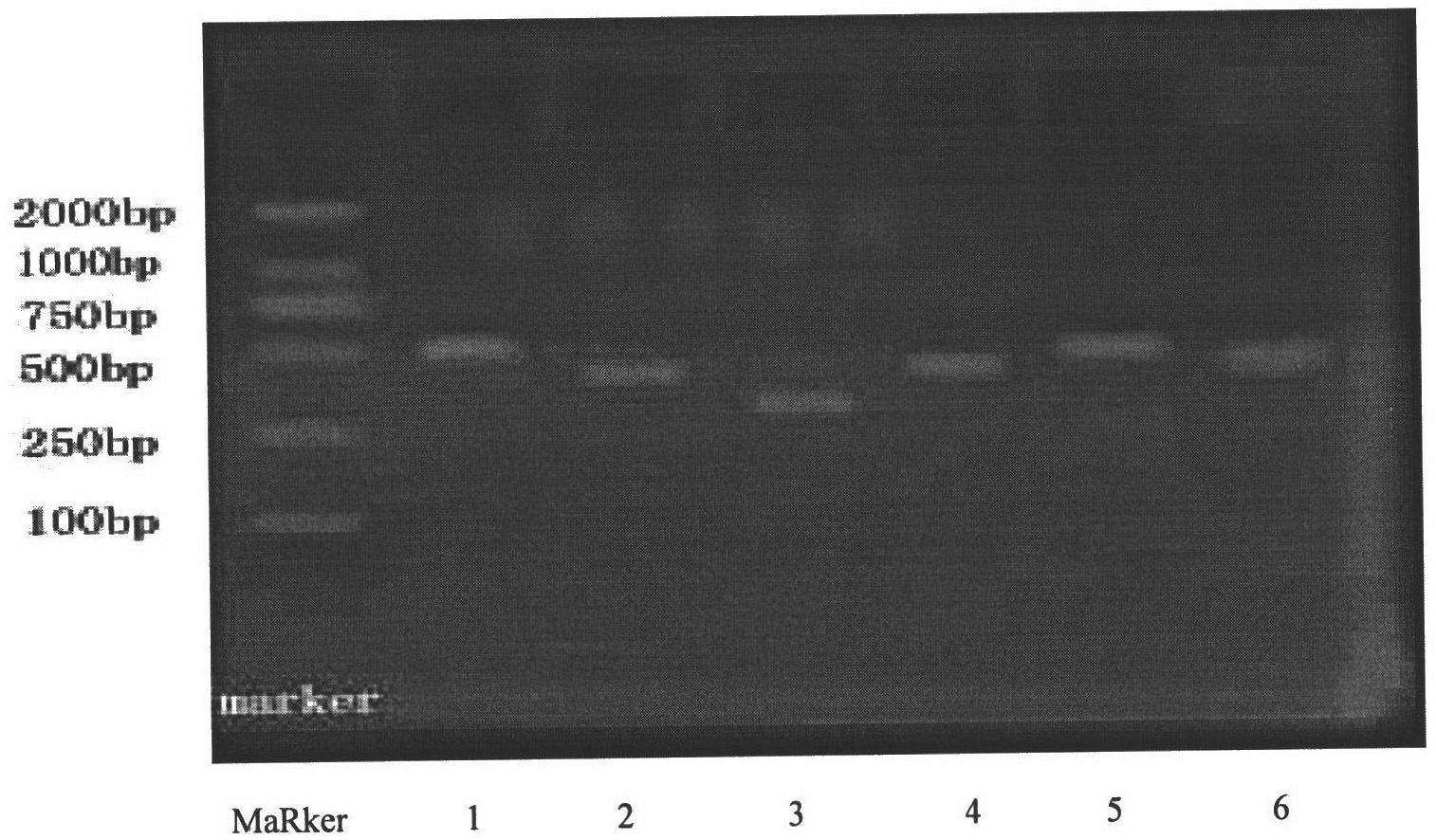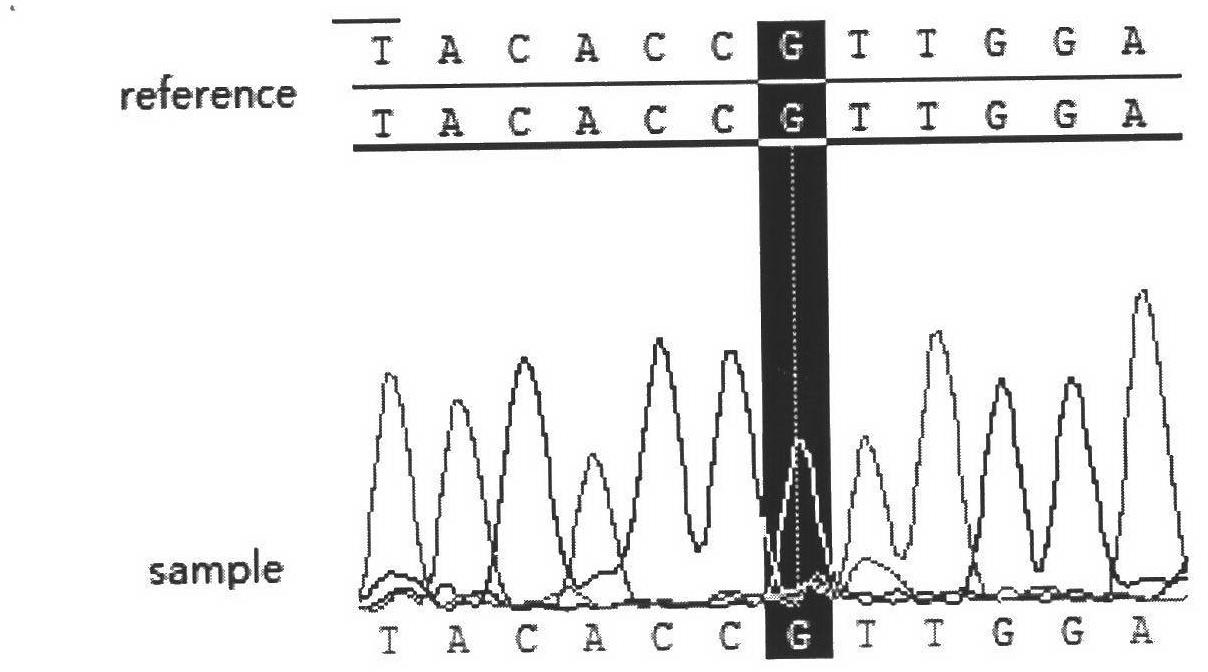Gene combination used for guiding individual treatment of platinum medicines
A platinum-based drug and gene combination technology, applied in the field of genetics, can solve problems such as differences in platinum-based drugs
- Summary
- Abstract
- Description
- Claims
- Application Information
AI Technical Summary
Problems solved by technology
Method used
Image
Examples
Embodiment 1
[0031] Example 1 A method for identifying mutations in GSTP1
[0032] 1. Extract the genomic DNA of the patient's tumor tissue;
[0033] 2. Perform PCR amplification. The 20 μl PCR reaction system is as follows: 50-100 ng of genomic DNA of the tumor tissue to be tested, 0.125 μl of Taq enzyme, 1 μl of upstream and downstream primers (10 μM), 2 μl of dNTP (2.5 mM), 10 × PCR buffer (containing Mg 2+) 2 μl, and the rest was sterile distilled water; the PCR reaction conditions were: 95°C pre-denaturation for 2 min, followed by 95°C denaturation for 30 sec, 55°C annealing for 30 sec, 72°C extension for 30 sec, 40 cycles, and finally 72°C extension for 7 min, 4°C storage ;
[0034] 3. Gel electrophoresis analysis of PCR amplification products:
[0035] a. Rinse the electrophoresis tank and comb with distilled water. Put it on a level table and set up the comb. 1.5% agarose can be prepared for electrophoresis.
[0036] b. Put 50ml of 1×TAE electrophoresis buffer and 100ml into a...
Embodiment 2
[0055] Example 2 A method for identifying MRP2 mutations
[0056] 1. Extract the genomic DNA of the patient's tumor tissue;
[0057] 2. Perform PCR amplification. The 20 μl PCR reaction system is as follows: 50-100 ng of genomic DNA of the tumor tissue to be tested, 0.125 μl of Taq enzyme, 1 μl of upstream and downstream primers (10 μM), 2 μl of dNTP (2.5 mM), 10 × PCR buffer (containing Mg 2+ ) 2 μl, and the rest was sterile distilled water; the PCR reaction conditions were: 95°C pre-denaturation for 2 min, followed by 95°C denaturation for 30 sec, 64°C annealing for 30 sec, 72°C extension for 30 sec, 40 cycles, and finally 72°C extension for 7 min, 4°C storage ;
[0058] 3. Gel electrophoresis analysis of the PCR amplification product: the specific steps are the same as in Example 1.
[0059] The result is as figure 1 As shown, band 3 represents MRP2, and its PCR product is 414bp.
[0060] 4. Sequencing of PCR amplification products: the specific steps are the same as i...
Embodiment 3
[0062] Example 3 A method for identifying mutations in XRCC1-Exon6
[0063] 1. Extract the genomic DNA of the patient's tumor tissue;
[0064] 2. Perform PCR amplification. The 20 μl PCR reaction system is as follows: 50-100 ng of genomic DNA of the tumor tissue to be tested, 0.125 μl of Taq enzyme, 1 μl of upstream and downstream primers (10 μM), 2 μl of dNTP (2.5 mM), 10 × PCR buffer (containing Mg 2+ ) 2 μl, and the rest was sterile distilled water; the PCR reaction conditions were: 95°C pre-denaturation for 2 min, followed by 95°C denaturation for 30 sec, 58°C annealing for 30 sec, 72°C extension for 30 sec, and 40 cycles, and finally 72°C extension for 7 min, and 4°C storage ;
[0065] 3. Gel electrophoresis analysis of the PCR amplification product: the specific steps are the same as in Example 1.
[0066] The result is as figure 1 As shown, band 4 represents XRCC1-Exon6, and its PCR product is 330bp.
[0067] 4. Sequencing of PCR amplification products: the specifi...
PUM
 Login to View More
Login to View More Abstract
Description
Claims
Application Information
 Login to View More
Login to View More - R&D
- Intellectual Property
- Life Sciences
- Materials
- Tech Scout
- Unparalleled Data Quality
- Higher Quality Content
- 60% Fewer Hallucinations
Browse by: Latest US Patents, China's latest patents, Technical Efficacy Thesaurus, Application Domain, Technology Topic, Popular Technical Reports.
© 2025 PatSnap. All rights reserved.Legal|Privacy policy|Modern Slavery Act Transparency Statement|Sitemap|About US| Contact US: help@patsnap.com



